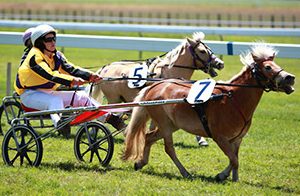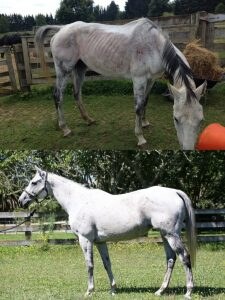Did you know that you are probably the very best person to determine if your horse is a “bit-off-colour”? You know “normal” behaviour for your own horse and you know their habits. Just by observing their day to day routine, you can get a feel for your horse’s general well-being and identify any changes that may indicate potential health issues. If you do become concerned about something, you will be better equipped to give the veterinarian a detailed account of when the horse was last normal and what has changed since then, to help in their assessment.
So what should you keep your eye on and what regular checks should you make to establish what is normal for your horse and then to monitor their health?
Here is a list of health checks that you should include:
Demeanour: Has your horse changed the way it acts? Horses should be alert and inquisitive, watching any changes in their environment. If your horse looks a bit sad, is uninterested in what is happening around them, and its head is down (and it is not eating or sleeping), your horse is off-colour and some further investigation is required. Contact your veterinarian.
Eyes: Your horse’s eyes should be open, clear and bright with no discharge or swelling. If you notice excessive discharge or weeping, swelling around the eye or in the corner of the eye, a closed or partially closed eyelid, sensitivity to light, or cloudiness, contact your veterinarian immediately. Eye problems are always an emergency and must be tended to urgently.
Appetite: Most people monitor how their horse is eating concentrate feed, but it is equally important to watch how much time is spent grazing in the paddock. Did you know that when turned out on pasture, a horse will graze about 18 hours a day? Keep an eye on your horse to see if it is spending more time grazing or standing around. If your horse is standing around more than grazing or leaving feed in its bin, then this should be investigated. Take your horse’s temperature and call your veterinarian immediately. Check their water, and look around the paddock or stall to see if they have been passing manure. The veterinarian will ask you about these things, as well as when your horse last had dentistry, and they will certainly do a more complete exam.
Water Consumption: Your horse needs access to clean, fresh water 24/7. A resting horse on a mild day can consume between 20 and 40 litres of water (five litres of water/100 kg of body weight). This amount can increase dramatically (up to 100 litres) after exercise, on hot days, or if lactating (broodmare feeding her foal milk). Horses also don’t like to drink water that is too cold, so if you live in cooler climates, make sure ice and snow is removed from water troughs and buckets. Some horses won’t drink as much if they graze on green, lush pastures as these will have a high-water content.
If you have difficulty getting your horse to drink, make sure the water is not too cold, is clean, and is fresh. If they are still not drinking that well, you can try offering an additional bucket of water with molasses or other tasty flavourings added to it to encourage drinking. Sometimes horses don’t like the smell or taste of plain water they are not used to. When you travel with your horse, if they are fussy about water, try bringing some from home, or if your horse enjoys a drink of molasses flavoured water at home, you can just bring some molasses with you to add to camouflage the taste and smell.)
Urine: Normal urine should be a pale yellow colour, a little like apple juice. If it is darker and thicker in consistency, it may be an indication of dehydration, kidney issues, or tying up. Due to the calcium content of equine urine, cloudy or foamy urine is also normal. Have you watched your horse urinating? Your horse should pass about 8-10 litres of urine per day and should urinate about every five hours. If your horse is having difficulty stretching out to urinate or stands unevenly while doing so, this could be an indication of lameness, muscle soreness, or kidney issues.
Manure: Have you checked your horse’s manure? If not, it might be time to take a closer look. Horse manure should be a rich medium brown colour and should be a formation of small round balls that shatter when they hit the ground. Your horse should pass manure six to eight times per day. In the spring, when pasture is more lush, the manure can have a green tinge and be quite soft. It can also be a bit loose at times of stress, after excessive electrolyte administration, or if there has been a change in diet. If soft manure continues for more than a few days, you should consult your veterinarian. Manure that is actually runny or is soaking the underside of the tail may indicate an urgent problem, so your veterinarian should be called immediately. If your horse’s manure is comprised of dry round balls that stay formed when they hit the ground, this can be an indication that the horse is suffering from dehydration.
Temperature: The normal body temperature of a horse should be between 37.0 and 38.5 degrees Celsius (98.6 and 101.3 Fahrenheit). Body temperature can be elevated because of inflammation and infection, but don’t forget, that a horse’s temperature can also increase when exercising, when rugged, in hot weather, and when they are excited. Body temperature fluctuates during the day, and it is often slightly higher later in the day. In mares, temperature can be seen to fluctuates with their heat cycle.
Body temperature should be taken rectally, ideally with a digital thermometer. (You can purchase a digital thermometer from your local pharmacy). If you have never taken a horse’s temperature before, get your veterinarian/instructor etc. to show you how.
Heart Rate: (Pulse) The resting heart rate of a healthy horse should be between 32-40 beats per minute (bpm). Draft horses will have a slightly lower normal rate, and foals will have a much higher one, up to 60-100bpm. Newborns will be towards the upper end of the scale, while older foals will have lower heart rates under normal conditions. Again, heart rate is affected by excitement, exercise, heat, pain, inflammation, and stress.
To take the heart rate, place a stethoscope on the chest just behind the elbow on the left side of the horse. Count the beats for a full minute, if you can, or for 30 seconds and then multiply by two to get the heart rate per minute. If you don’t have a stethoscope, don’t worry. You can take the pulse by putting your finger on the mandibular artery, found running your finger across the underside of the jaw, just where it joins the cheek or in the groove under the jaw inside the cheek, the radial artery on the inside of the knee, or the digital arteries at the back and bottom of the fetlock and along both sides of the pastern, at 4 and 8 0’clock. Be sure to use your fingers as you might feel the pulse in your own thumb.
Respiration Rate: (breathing) Watch your horse breathing over a full minute. When it inhales and then exhales, it has taken one breath. The normal respiratory rate for an adult horse at rest is 8 to 12 breaths per minute. In contrast, a new born foal will breathe 60-80 times a minute, and an older foal will take 20-40 breaths. As with a horse’s temperature, the respiratory rate will also increase with exercise, excitement, and in hot weather.
You can use a few different techniques to count the respiratory rate. The simplest way is to stand near your horse’s shoulder, facing towards its hindquarters, and watch its abdomen move in and out (one breath). As an alternative, you can feel for the air coming out of the nostril on your hand. If you have a stethoscope, the best way may be to listen to the breath sounds as air passes through the trachea (windpipe). This will enable you to hear the quality of the sounds your horse makes when breathing. You might notice deep or shallow breaths, and you might hear unusual crackling or whistling sounds that are an indication that you should consult your veterinarian.
Mucous Membranes: The mucous membrane are the tissues that line the gums, inside of the mouth, inside of the eyelid, inside of the nostrils, and the sac in the corner of the eye. They should be pink in colour and moist to touch. If the gums are dry or tacky, this can be an indication that the horse is dehydrated. Check the colour of your horse’s gums. If they are white, dark red, blue, or yellow-tinged, call your veterinarian immediately! These changes in colour indicate serious health issues.
Capillary Refill Time: This gives a good indication of how well the horse’s circulatory system is working. (A normal capillary refill time indicates that blood and oxygen is moving efficiently around the body). Push your finger on the gum for a few seconds until the gum in that area goes white, then release. The area should return to its original pink colour, within two seconds, as the blood returns to the area. If it takes longer than two seconds to return to normal, or if the gums are any colour but pink, call your veterinarian.
Skin Pinch Test (Skin Tent): This is another test to check your horse’s hydration status. On the neck, or on the upper eyelid if you are able, pinch a piece of skin between your thumb and forefinger for a second. When you release the skin, it should return to normal within one second. If it stays pinched for more than a second, there is the possibility of dehydration. The skin tent performed on the neck can be affected by age and body condition, with older animals and thin animals having a slower skin tent than younger and thinner animals. In horses, unlike in humans, the loose skin above the eye isn’t as affected by age, and fat doesn’t really accumulate under the eyelid.
Gut Sounds: You will generally need a stethoscope to listen to your horse’s gut sounds, though by simply pressing your ear to your horse’s flank in the right place, you will likely hear some. Place your stethoscope on the belly, just behind the ribs and in front of the stifle, on both sides. The second place to listen is a little further straight up from there, about the width of your hand in front of the whorl and about a hand’s width below it. Depending on the size of your horse, the specific location varies, so ask your veterinarian to help. You should be able to hear fluid rushing, tinkling, squeaking, gurlgling or rumbling in all four areas, but you will likely hear less in the top left area than in the others. You must be patient to hear gut sounds as they are not continuous. Listen for a full minute in all four places. Ideally, we expect to hear the sounds of gut contents moving a couple of times a minute. Researchers have found that eating or drinking results in more food particles and fluid passing through the digestive tract and an increase in gut sounds. If the rumbling continues at a much higher rate than normal, it may indicate some underlying issue and a veterinarian should be consulted. If gut sounds are very infrequent or not present at all, this can be cause for concern as there may be a blockage. Call your veterinarian immediately. In general, a slightly more active gut is not serious while a quiet gut will always require urgent veterinary care. Check your horse’s stall/paddock/stable for manure as this is a good indication of how long it has been since the gut was working normally.
Hoof Wall Temperature: An easy health check for your horse is to feel each hoof to see how hot it is. Hoof walls should generally be cool to touch, however each horse will be different. Get to know how warm your own horse’s hooves are in a variety of conditions. Exercise and warm weather can cause them to have an increase in temperature, so mildly warmer feet are not always a problem. It is especially useful to compare the temperature of the feet to each other. If one foot is warmer than the other, that is reasonably reliable indication of inflammation in the warm foot. It may indicate a bruise, the start of a hoof abscess, coffin joint synovitis, or a fracture. Tip: Watch to see if all four feet dry at a similar speed. Warmer feet will dry faster. If both feet are unusually hot for the conditions, it may be an indication of laminitis. A sudden flare up of laminitis is always an emergency, so call your veterinarian immediately!
Digital Pulse: Another indication of inflammation in the foot is a digital pulse. The digital pulse can be found on the back of the fetlock at the base of the sesamoids. By gently pressing and sliding your fingers side to side at the back and base of the fetlock, you can often feel the firm digital artery, which supplies blood to the extremities, roll under your finger. Once you locate it, lighten the pressure slightly to feel the pulse through it. You can also feel the digital arteries as they continue along the pastern at 4 and 8 o’clock, and only light pressure is required to feel the pulse here. If the pulsing or throbbing is quite strong and you can feel it easily, this may actually be an abnormal digital pulse and your veterinarian may need to do some further investigation. The normal digital pulse is a tricky one to locate, and this can be even more difficult on fit, healthy horses. If you get the opportunity, ask your veterinarian or instructor to show you how to locate it and try to get familiar with how mild that pulse is when it is normal.
My mentor in veterinary college, the great Dr. Otto Radostis, began all of our Large Animal Medicine lectures with a bit of his personal philosophy. This was one piece of wisdom he tried to impart on us that I will always remember. He said, “You miss more for not looking than for not knowing”. The best thing you can do is observe your horse in their environment, each and every day. Run your hands over them from top to toe, and get comfortable with doing the extra checks listed above. Keep a record of everything you see and of the daily health parameters you measure. Keep the information in your first aid kit (read our First Aid Kit blog article by clicking here) or stable so you have easy access to it. Remember, the sooner you notice that something is amiss and contract your veterinarian, the better the outcome is likely to be. Also, the more information you can give the veterinarian about normal and abnormal for your horse, the easier it will be for them to accurately assess your ailing equine friend.
“You miss more for not looking than for not knowing.” Dr. Otto Radostits



